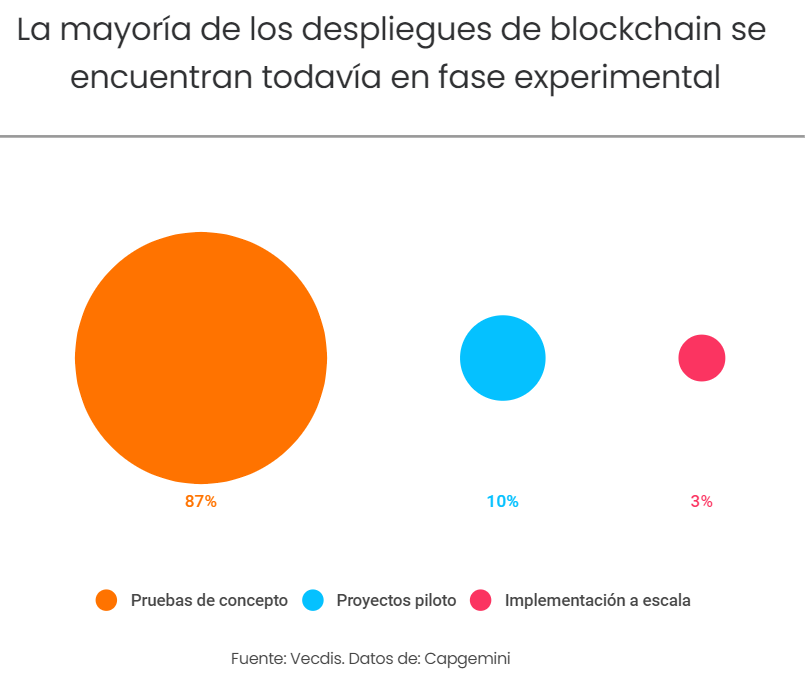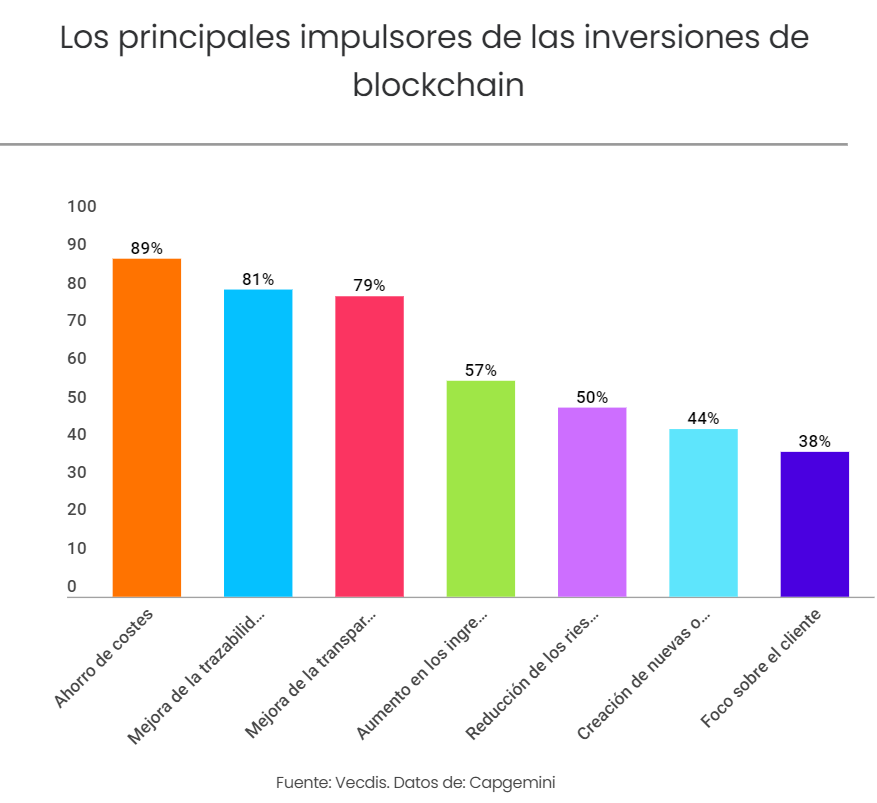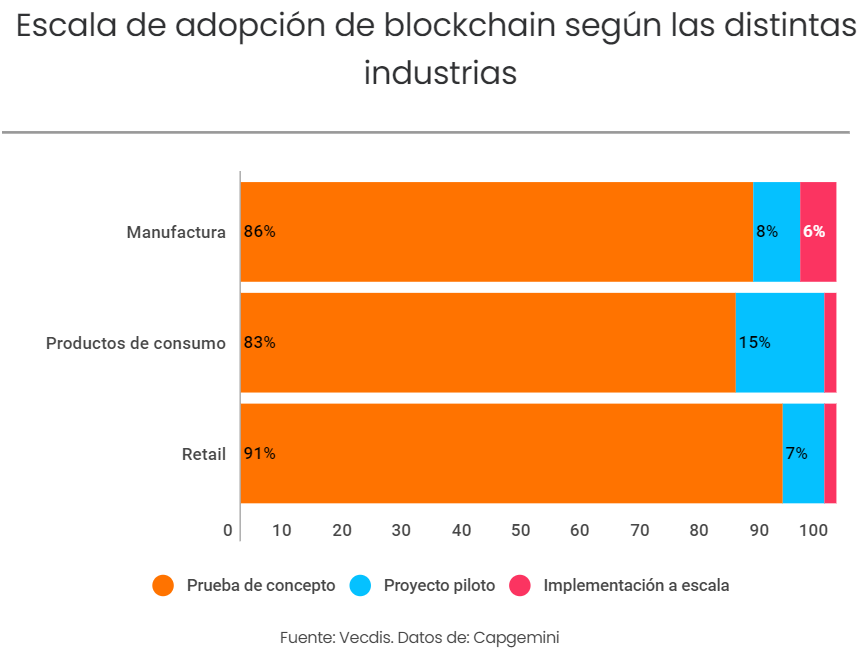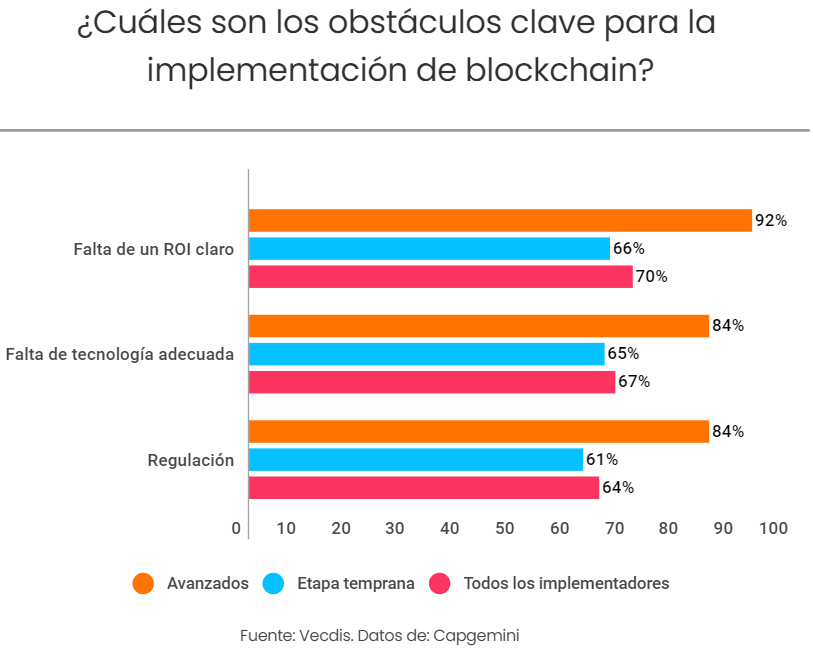Only 3% of the companies have implemented Blockchain at scale

The complexity of supply chain management, together with the need for greater transparency has increased the interest of companies in the functionalities that I can offer the blockchain. As a technology that promises to provide an opportunity to address some of the perennial problems that compromise the effectiveness of the supply chain, such as lack of traceability.
To do this it is necessary to understand more deeply the maturity of blockchain in the supply chain domain, and identify its different possibilities in different sectors.
For some organizations belonging to the manufacturing, consumer products and retail industry, they already have blockchain implementations in proof-of-concept, pilot or implementation at scale. It is interesting to assess the challenges they face with their initiatives in three main areas:
- How blockchain can help organizations address supply chain issues and the maturity status of this technology.
- Examples of applications that are gaining traction in the real world.
- Best practices for a resilient blockchain program.
How to deal with problems?
Blockchain can address problems in the supply chain, such as traceability. One example is how through the use of this technology food companies can struggle to identify contaminated products.
Blockchain’s ability to track products can improve the management of the business crisis. If a group of consumers gets sick in the same area, having consumed the same product, it can be analyzed which retailer comes from. Once the responsible product is identified, the blockchain can be used to verify the audit trail, includingthe origins of its ingredients and finally the ingredient that is causing the problem.
In addition to ensuring the provenance of the goods, this technology has other applications that allow it to act at different stages of the chain, and in this way eliminate critical points where it fails and in turn improves r trust,transparence and security.
On the other hand, the decentralized and autonomous blockchain model becomes an ideal base for other technological disruptors such as the Internet of Things (IoT) or Artificial Intelligence (AI).
Despite being able to see in a real example how blockchain can help companies, reality is far off, since most deployments of this technology are still in the experimental phase.

Key drivers for investment range from cost efficiency to revenue growth. In 2018, four out of five (80%) organizations that have blockchain implementations claim that this technology’s ability to track products and provide better transparency is driving their investment.

Where to allocate the investment?
According to the study: “Does blockchain hold the key to a new age in supply chain transparency and trust?” performed by Capgemini, more than twenty types of blockchain use are identified. Including:
- Managing supplier contracts
The manufacturing sector has a large number of organizations that have already implemented the blockchain on a large scale. Even some companies have already made significant incursions with blockchain.

Foxconn has launched a blockchain-based supply called to Chained Finance as part of s efforts to provide working capital to its base supply chain. What gives weight to what is said by the CEO of FnConn, a subsidiary of Foxconn:
“By using the blockchain-based financial platform, every payment, every offer carried out in the chain transaction can be more transparent, manageable, and easily authenticated to. Blockchain-based finance will provide timely and efficient support to many more suppliers, regardless of size. And it will also help ensure the timely delivery of products to end customers, improving efficiency throughout the entire supply chain.”
Large organizations deal with multiple suppliers, especially in manufacturing. Traditional contract management involves a long and lengthy process of negotiation, authorship, execution, payment and renewal. These activities need to be coordinated among many organizations and multiple departments within those organizations. Estimates show that inefficiencies in supplier management, purchasing and transportation management only cost UK companies 2 billion dollars a year.
Blockchain technology can make these contracts smart, scheduling them to execute themselves when certain events happen. With blockchain, organizations can configure an ared peer-to-peer in which different parties can interact withoutan intermediary verifying it.
This improves execution speed and enables faster resolution and payment mechanism for the suppliers involved. For example, a delivery receipt from a vendor can trigger an automatic material quality inspection, if the inspection is successful, a digital payment is automatically activated. This will help reduce vendors’ working capital requirements.
- Organizations can focus on the origin
At least in 2018 15% of the manufacturers of consumer products around the world have pilot blockchain initiatives. Among the main reasons companies have to start this path are tracking where they come, tracking parameters critically, tracking assets, regulatory compliance, and the power to provide collateral.
Source tracking allows organizations to track products throughout the supply chain, from source to customer. This feature has applications in many fields, from luxury products to pharmaceuticals, from art to agriculture.
On the other hand, ensuring the safety and authenticity of certain products such as baby food, pharmaceuticals, dairy and premium meats is of paramount importance. Today, there is an added emphasis given the high levels of counterfeiting, and special ly one-commerce.
- Retailers focus on the digital market and counterfeit prevention
Leading online sales leaders such as Amazon or Alibaba carry the burden of user mistrust, which can lead to increased costs and slowing growth.
Market participants should be able to verify and audit the transactions, including the credentials and reputation of the parties involved and the characteristics of the goods and services exchanged.
Blockchain technology fundamentally transforms the traditional flow of information and third-party verification. Any transactions or information on the agents and assets involved, can be verified a with a low and in real time. Trust in the broker is replaced, with confidence in the code-behind and consensus rules. With this technology, the incremental cost of verification is minimal even as these market models evolve in the future.
Coupit is an example of a blockchain-driven e-commerce, designed to help verify the reputation of buyers and sellers. Each time a transaction is established, a claim is recorded, a problem is resolved, or left unresolved, a review is written, or any other transaction event occurs, the associated information is summarized, updated in the blockchain, and made available to authorized users who will participate in future transactions.
Blockchain has the potential to enable a new wave of Ⅰinnovation in digital markets. This is highly relevant for this type of industry and also for consumers and product companies that want to launch an infrastructure to partner with blockchain-enabled loading platforms or retail markets.
On the other hand, digital businesses, including e-commerce, social commerce, and consumer-to-consumer platforms, have been plagued by counterfeits. In 2018, counterfeit products accounted for 2.5 billion world trade, amounting to $461 billion. Using blockchain, retailers can provide customers with undisputed proof of the provenance and authenticity of their products.
A resilient blockchain program
While many believe in the promise of blockchain, only the 3% of the organizations that have implemented blockchain have done so at scale. Which leads us to think that something is wrong when it comes to adopting a blockchain program.
While blockchain has many potential use cases, organizations will be sure that they are not using it to address a problem that could be solved by an alternative solution. So the first thing organizations have to do is wonder if their current solutions implemented in the supply chain, with additional customization, can offer the same benefits as a blockchain implementation.
Blockchain can be the right answer if the following conditions are met:
- Traceability and authenticity are a critical aspect of the supply chain and are difficult to achieve with the current strategy.
- The organization seeks to eliminate or minimize the costs associated with certain brokers, such as the cost of delivery validation or an audit process to improve efficiency across the entire value chain.
- The organization wants to see new businesses based on trust.
The benefits of blockchain lie in its transparency, traceability and immutability. Organizations must determine which critical points in their supply chain they want to address and clearly assess whether blockchain is the best solution and then identify the use.
After evaluating the need for blockchain, organizations also need to ensuresand have the talent required for such an implementation.
There are many aspects to consider, three out of five organizations worldwide in 2018 say that the lack of compatibility between their IT systems and the IT systems of partner organizations inhibits the implementation of theblockchain.
Finally, while many organizations are investing in blockchain, most say that establishing the return on investment (ROI) is a major challenge. And nearly half of the organizations (49%) surveyed also noted that supply chain processes require major transformations before implementing a blockchain solution.

Conclusions
Supply chains have become increasingly complex with years. Traceability, responsiveness, and trust issues remain barriers to making the supply chain more efficient.
The blockchain’s ability to eliminate these restrictions can also increase value, reducing inefficiencies and creating new opportunities. However, despite the compelling opportunities, there have been only a few large-scale implementations of this technology.


